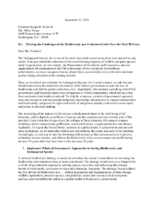
The Endangered Species Act
Once a touchstone of bipartisan support, this landmark legislation is now under attack
The Endangered Species Act (ESA) is one of the nation’s strongest laws for protecting wildlife and has been credited with saving 99% of species listed under it from extinction. For 50 years, the ESA has played a vital role in not only safeguarding our nation’s treasured species, like iconic Bald Eagles, Gray wolves, and Beavers, but also protects endangered and threatened international species such Siberian tigers, African lions, and Cheetahs.
At the same time, the ESA's ability to provide species recovery, along with getting species listed in the first place, has been undermined for decades as the ESA remains one of the most attacked pieces of legislation in US history. Despite the law’s tangible successes and overwhelming public support, it is a target for pro-development and anti-regulatory entities.

Cheetah Sasha at LIONSROCK Big Cat Sanctuary
As science has continued to evolve over the decades, we’ve learned how vital it is to take a holistic approach to conservation and species protection by ensuring not just protection from physical harm, but by also considering species reliance on the environment they live in, the food they eat, and a multitude of other factors that impact their survival. The balance needed to achieve species stability however has been threatened at an alarming and increasing rate from human activity. This has resulted in the ongoing climate crisis and unprecedented rate of biodiversity loss across the planet, including 41% of ecosystems in the United States being at risk of range-wide collapse and global wildlife populations having declined by an average of 69%. Unfortunately, the scientific strength and enforcement ability of the ESA, which is desperately needed right now to face the current extinction crisis, have been undermined for decades by politics and the endless quest for profit.
This is why FOUR PAWS USA has joined with hundreds of other organizations in calling on Congress and the Biden Administration to protect and strengthen the existing ESA and to oppose harmful bills that attack wildlife, endangered species, and at-risk habitats. As part of the ESA@50 coalition, we are also urging the Biden Administration to take more government action against ongoing biodiversity loss and the extinction crisis by creating a national biodiversity strategy, among other policy recommendations.

Tiger Raspoetin at LIONSROCK Big Cat Sanctuary


